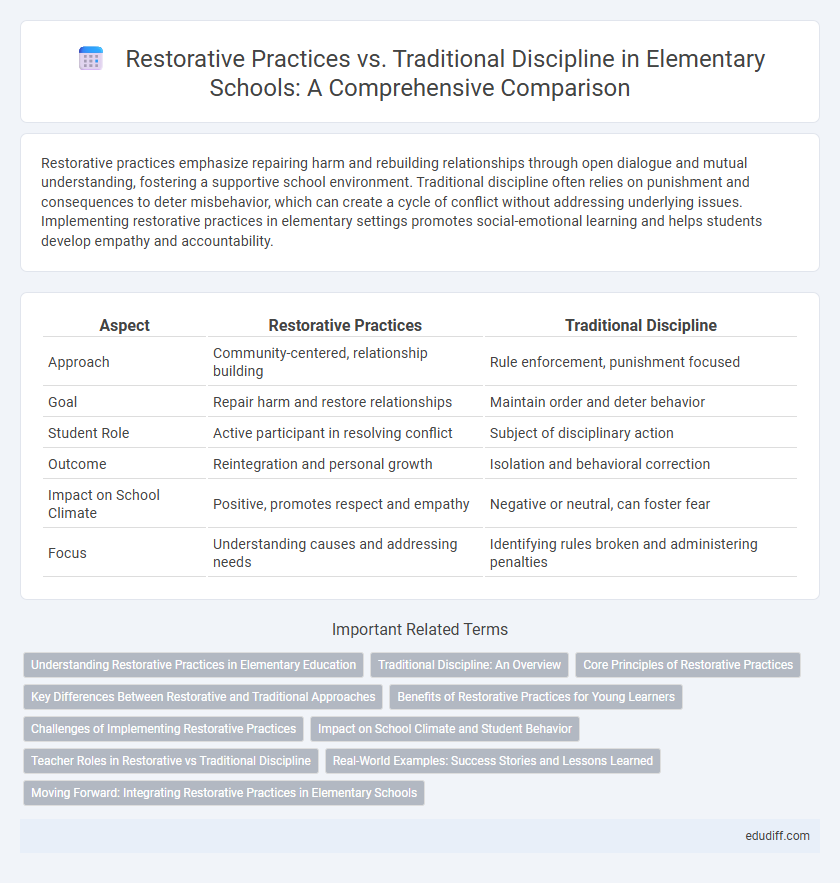Restorative practices emphasize repairing harm and rebuilding relationships through open dialogue and mutual understanding, fostering a supportive school environment. Traditional discipline often relies on punishment and consequences to deter misbehavior, which can create a cycle of conflict without addressing underlying issues. Implementing restorative practices in elementary settings promotes social-emotional learning and helps students develop empathy and accountability.
Table of Comparison
| Aspect | Restorative Practices | Traditional Discipline |
|---|---|---|
| Approach | Community-centered, relationship building | Rule enforcement, punishment focused |
| Goal | Repair harm and restore relationships | Maintain order and deter behavior |
| Student Role | Active participant in resolving conflict | Subject of disciplinary action |
| Outcome | Reintegration and personal growth | Isolation and behavioral correction |
| Impact on School Climate | Positive, promotes respect and empathy | Negative or neutral, can foster fear |
| Focus | Understanding causes and addressing needs | Identifying rules broken and administering penalties |
Understanding Restorative Practices in Elementary Education
Restorative practices in elementary education emphasize building positive relationships, promoting empathy, and repairing harm through open communication rather than focusing on punishment. These approaches create a supportive learning environment that encourages accountability and social skill development among young students. Studies show that restorative practices reduce suspension rates and improve student behavior and academic outcomes compared to traditional disciplinary methods.
Traditional Discipline: An Overview
Traditional discipline in elementary schools typically involves clear rules and consequences such as detention, suspension, or loss of privileges to manage student behavior. This approach emphasizes maintaining order and authority through consistent enforcement of established guidelines. Although effective for immediate compliance, traditional discipline may not address underlying issues causing misconduct or promote long-term positive behavior change.
Core Principles of Restorative Practices
Restorative practices in elementary education emphasize building relationships, fostering respect, and promoting accountability through open communication and community involvement. These core principles focus on repairing harm and restoring trust rather than punishing misbehavior, encouraging students to take responsibility and develop empathy. This approach contrasts with traditional discipline methods that often prioritize rule enforcement and consequences without addressing underlying causes or emotional impacts.
Key Differences Between Restorative and Traditional Approaches
Restorative practices in elementary education prioritize repairing harm and building relationships through open dialogue and community involvement, while traditional discipline focuses on punishment and rule enforcement. Restorative approaches encourage accountability and empathy by involving students in resolving conflicts, whereas traditional methods often rely on consequences like detention or suspension to manage behavior. The key difference lies in restorative practices fostering understanding and social-emotional learning, contrasting with the more rigid, punitive nature of traditional disciplinary systems.
Benefits of Restorative Practices for Young Learners
Restorative practices promote positive relationships and emotional growth by encouraging young learners to understand the impact of their actions and take accountability. These approaches reduce behavioral issues and increase student engagement, fostering a safe and supportive classroom environment. Implementing restorative circles and discussions helps build empathy and social skills among elementary students.
Challenges of Implementing Restorative Practices
Implementing restorative practices in elementary schools faces challenges such as requiring extensive teacher training and time to facilitate meaningful conversations between students. Resistance from staff accustomed to traditional discipline methods can hinder consistent application and effectiveness. Limited resources and administrative support often complicate the integration of restorative approaches into existing school policies.
Impact on School Climate and Student Behavior
Restorative practices foster positive school climate by promoting empathy, accountability, and meaningful dialogue, which reduces incidents of misbehavior and improves student relationships. Traditional discipline often relies on punishment and exclusion, leading to increased student alienation and higher rates of recidivism in misbehavior. Schools implementing restorative approaches report enhanced student engagement, lower suspension rates, and a more supportive, inclusive environment.
Teacher Roles in Restorative vs Traditional Discipline
Teachers in restorative practices act as facilitators who guide meaningful conversations, encourage empathy, and help students understand the impact of their actions, fostering a supportive classroom community. In traditional discipline, teachers primarily serve as enforcers of rules, issuing consequences such as detention or suspension to manage behavior. Restorative roles emphasize relationship-building and conflict resolution, while traditional roles focus on compliance and punishment.
Real-World Examples: Success Stories and Lessons Learned
Restorative practices in elementary schools, such as peer mediation programs and community circles, have led to significant reductions in suspensions and improved student relationships compared to traditional discipline methods. For example, a Chicago elementary school reported a 40% drop in behavioral referrals after implementing restorative circles, emphasizing empathy and accountability over punishment. These success stories highlight the importance of repairing harm and fostering a supportive school environment to improve both student behavior and academic outcomes.
Moving Forward: Integrating Restorative Practices in Elementary Schools
Integrating restorative practices in elementary schools fosters positive relationships and reduces repeat behavioral issues by emphasizing accountability and empathy over punishment. Data from schools implementing these approaches show improved student engagement, decreased suspension rates, and enhanced social-emotional learning. Ongoing teacher training and community involvement are critical components for successfully moving forward with restorative discipline models.
Restorative Practices vs Traditional Discipline Infographic

 edudiff.com
edudiff.com